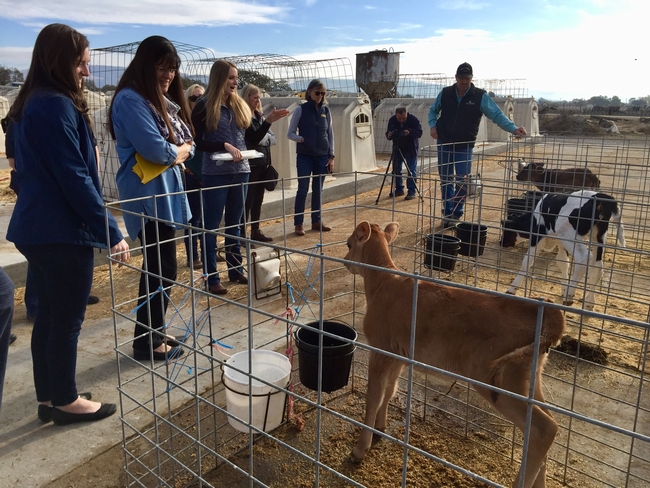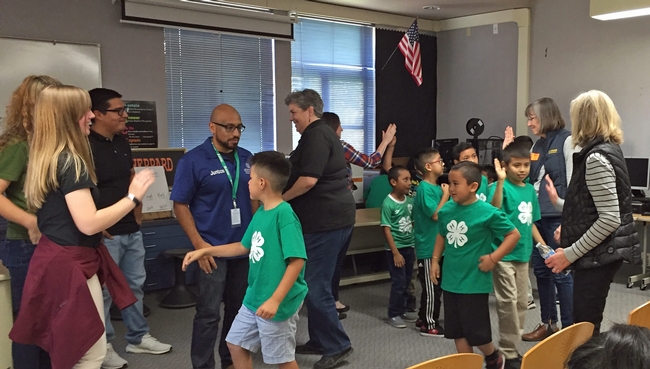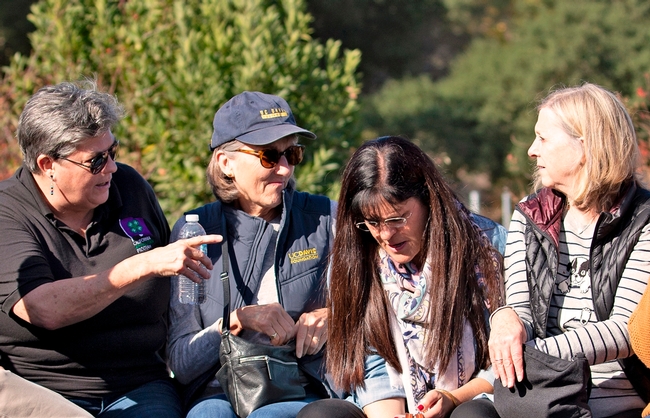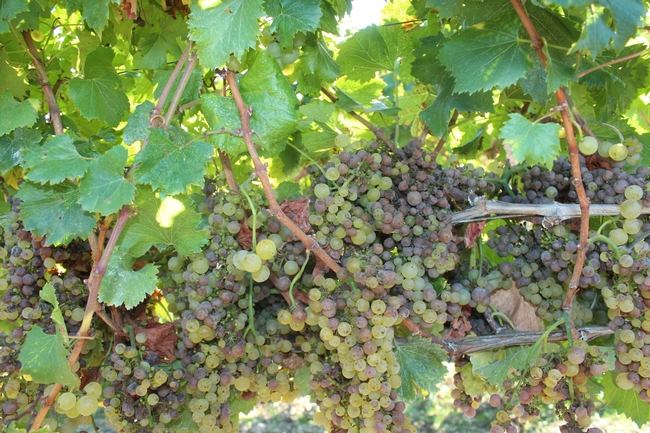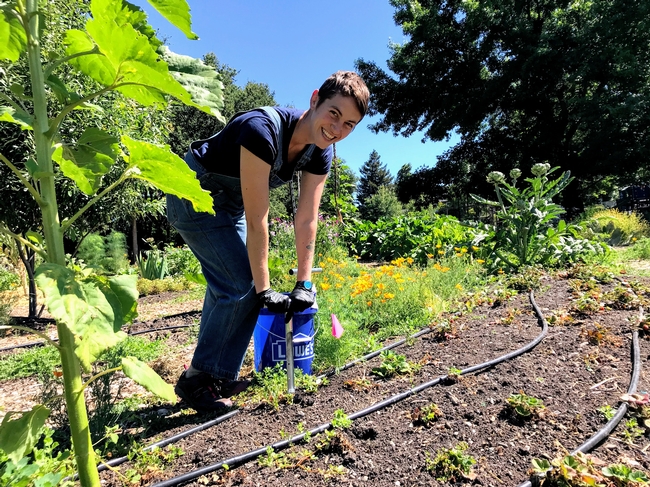- Author: Pamela Kan-Rice
Vice President Glenda Humiston introduced alumni regent-designate Debby Stegura to UC Cooperative Extension staff and their community partners and clientele in Sonoma County on Nov. 15.
After visiting Beretta Dairy, Bayer Farm Park and Gardens, Sheppard Elementary and Stuhlmuller Vineyards, Regent Stegura tweeted:
“Blown away by @ucanr tour of @UCCESonoma work—Beretta Dairy, @UCMasterGarden, @Stuhlmullerwine, @California4H. Saw #kincaidfire reach, how to prepare better for future fires. @ucanr work benefits all of CA. Thank you!”
The retired business litigator and UC Davis alumna was joined on the tour by Anne Shaw, secretary and chief of staff to the regents, and Michael Bedard, UC state government relations legislative director.
Stephanie Larson, UCCE director for Sonoma County, led the tour, which first visited Beretta Dairy.
“It's so nice to have a dairy advisor,” Sonoma County dairy farmer Doug Beretta said, crediting Randi Black, UC Cooperative Extension dairy advisor, with providing the technical assistance he needed to apply for a grant to reduce methane emissions.
Black, who joined UC ANR in 2017, helped four local dairies obtain grants totaling $2.5 million and said the projects propose to reduce emissions by 9,327 metric tons of CO2 equivalent over the next 5 years, which is comparable to removing 2,028 passenger vehicles from the road for a year.
Beretta talked about the work he has done at the dairy, based on UC research, to improve water quality. David Lewis, UCCE director for Marin and Napa counties, noted that similar manure management and water-quality work is being implemented by UCCE clientele in his counties.
Discussing the hardships created by low milk prices in the dairy industry, Beretta said he appreciated UCCE's agricultural ombudsman Karen Giovannini guiding producers who want to sell value-added products through the permitting process.
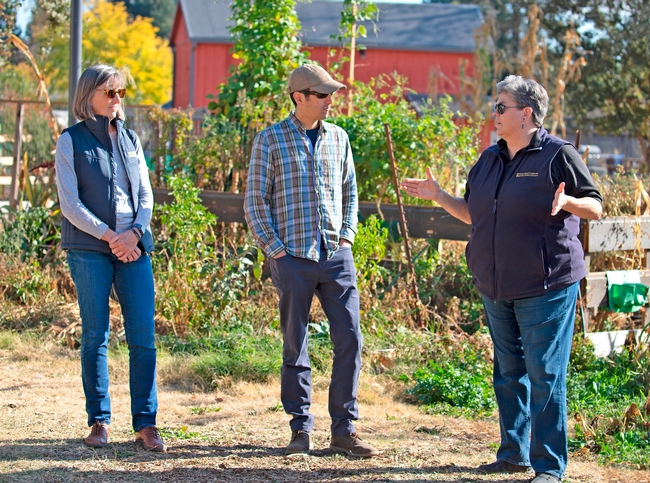
From the dairy, Stegura and the group met with Mimi Enright, UC Master Gardener Program manager for Sonoma County, UC Master Gardener volunteers and Julia Van Soelen Kim, North Bay food systems advisor at Bayer Farm Park and Gardens.
Collaborating with Bayer Farm, the Master Gardeners have been expanding outreach to Spanish-speaking members of the community. In addition to all of the traditional Master Gardener outreach, the Master Gardeners in Sonoma County have been actively promoting firewise landscaping to help Sonoma County residents better prepare for wildfires. Using UC ANR materials is critical, Enright said, to assure people the recommendations are based on scientific research. 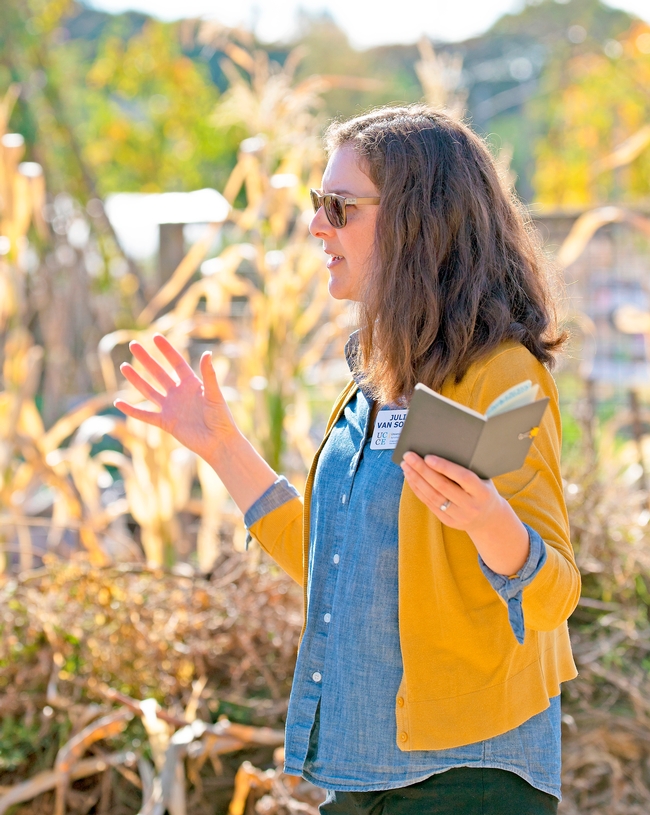
After the wildfires in 2017, Van Soelen Kim and Enright launched a citizen science project with community partners to assess produce safety. Within days of the fire, volunteers collected 200 samples of leafy greens from school, backyard and community gardens. With funding from UC ANR and the Bay Area Air Quality Management District, they expanded testing to soil and partnered with UC Davis researchers to test eggs laid by backyard poultry, and published guidance for produce safety after urban wildfire.
After the Kincade Fire, when growers and gardeners asked if produce grown outdoors was safe to eat, Enright said UCCE Sonoma County could tell them, based on local research, it was safe to eat if consumers removed outer leaves and washed the produce and that the health benefits of eating fresh produce outweigh any trace contamination.
UCCE has been leading a coalition of community partners and government organizations to educate the community on reducing food waste and increasing food recovery. When PG&E announces public safety power shutoffs, they promote composting food that can't be eaten so it doesn't end up in a landfill.
“This kind of service in communities is not as well-known about UC as the campuses,” Humiston commented to the regent.
Across the street from Bayer Farm, Diego Mariscal, 4-H program assistant, has been collaborating with Sheppard Elementary School. It is one of several schools in the county providing 4-H afterschool clubs and other 4-H programs designed to nurture the next generation of Latino leaders. Last spring, Mariscal worked with families to build a 4-H soccer league for elementary school children. Parents, college and high school students were trained by 4-H to teach children teamwork, soccer skills and healthy eating habits. More than 200 new underserved youth participated in 4-H programs in Sonoma County during the 2018-2019 year.
A few of the soccer players, proudly wearing their green 4-H soccer uniforms, told the group what they liked about 4-H. 4-H All Star Corrianna E., who participates in the 4-H teen program, shared her experience in 4-H and expressed gratitude to the program for helping her overcome her shyness to become a strong public speaker. Corrianna's mother, Naomi Edwards, also shared her experience as 4-H Council President for Sonoma County.
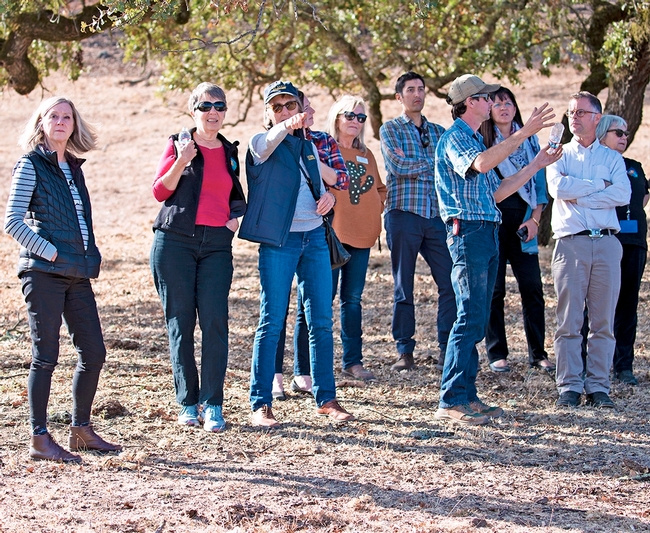
“You want to know what's a good cultural practice? Rhonda Smith has answers backed up by hard science,” Gorman said of the UCCE viticulture advisor. 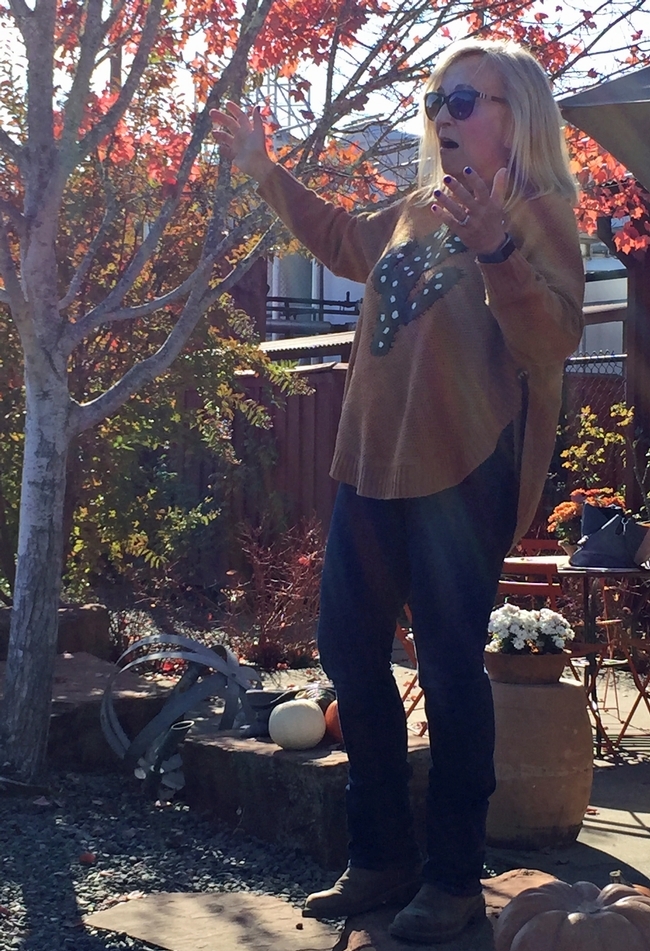
When new landowners ask Gorman for advice, he refers them to Steven Swain, UCCE environmental horticulture advisor, who advises small parcel land managers in Sonoma County on managing the land for fire and wildlife. “Without UCCE, where would they turn?” Gorman asked, adding that people from private companies may have recommendations that may not be in best interest of the land.
Larson introduced new UC IPM advisor Cindy Kron, who succeeds recent retiree Lucia Varela. Kron is launching an IR-4 project to study pesticides for olives, which isn't a big enough market to interest private investment in research. She's also monitoring pears for brown marmorated stink bug because early detection is key to controlling the pest. Spotted lanternfly isn't in California yet, but grapes are among its favorite hosts so Kron is working with UC Master Gardener volunteers and other community members to watch for the exotic pest.
The Kincade Fire destroyed fences and scorched the rangeland at Stuhlmuller Vineyards, forcing Gorman to sell the cattle. He showed the group where the fire failed to advance at the fire break created by the lush vineyards. As a result of the Kincade Fire, Gorman wasn't able to sell his petite verdot, chardonnay and cabernet grapes to wineries. To prove to the insurance company that smoke damaged the crop, his crew picked 30 tons of grapes for testing.
During and after the devastating fires in the North Bay, Larson, who is also a UCCE livestock and range management advisor, assisted livestock owners to gain access to their burned properties; this ensured their animals got food and water. She also organized resource meetings for landowners affected by fires, helping them apply for funding from government agencies and insurance companies for animal, forage and facility losses.
Larson also said her new grazing database Match.Graze has been well-received by ranchers and landowners in Sonoma and Marin counties who want to use grazing to reduce fire fuels. Land managers and grazers can sign up at ucanr.edu/matchgraze to hire sheep, goats, cattle and horses to manage fire fuels.
The regent tours in Sonoma Country and Fresno County were coordinated by Anne Megaro, government and community relations director. She is planning future tours for regents at UC South Coast Research and Extension Center and other locations in the spring.
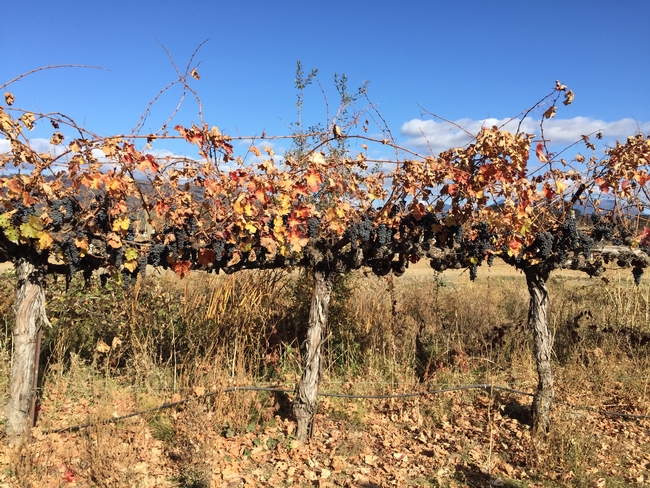
- Author: Cindy Kron
- Contributor: Karen Giovannini
The spotted lanternfly (SLF) is a new invasive pest that has recently arrived in the United States. This planthopper has a wide host range of 70+ plant species including grapevines, apple, cherries, stone fruits, ornamentals, etc… with its preferred host being the tree of heaven. SLF lays their eggs on inanimate objects such as railway cars, outdoor furniture, stones, wood pallets, and vehicles which aids in their ability for wide dispersal.
Learn About Spotted Lanternfly
Lifecycle, Preferred Hosts and Potential for Damage
Early detection is key to keeping the spotted lanternfly our of Sonoma county. Everyone, including growers, PCAs, field workers, and home gardeners can play an important role in keeping the spotted lanternfly out of California by being the eyes and ears needed for early detection. Take the time to become aware of how to identify this new exotic pest and report any suspected sightings to your local Agricultural Commissioner's office right away.
Together we can help keep the spotted lanternfly out of California!
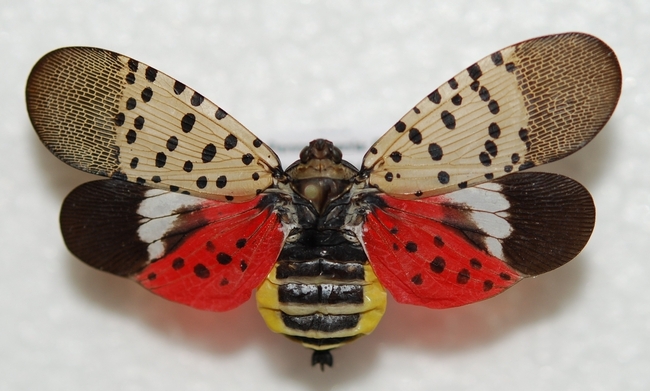
- Author: Rhonda J Smith
- Contributor: Akif Eskalen
For the first time many growers are facing the dilemma of what to do with fruit that will not be sold. Although wine inventories have been slowly building over the past few years, 2019 is the first year in which a number of growers are feeling the effects of excess supply due to the large 2018 crop.
Given that yields thus far for most growers have been “average” or better and there is significant unsold inventory of bulk wines, custom crushing uncontracted grapes in 2019 may not be a viable option. Hopefully there will be buyers as the harvest continues but in this market, the prices offered are likely to be less than the cost of production.
Allowing unsold fruit to remain on the vines may seem unthinkable yet with no income from those blocks, it makes sense. This means not dropping clusters by hand and not running a harvester in the vineyard to get the berries off.
From the perspective of a plant pathologist:
clusters that decompose over the winter - either on the vine or on the ground -
are not likely to have a noticeable effect on fungal disease pressure the following year given common vineyard floor management practices.
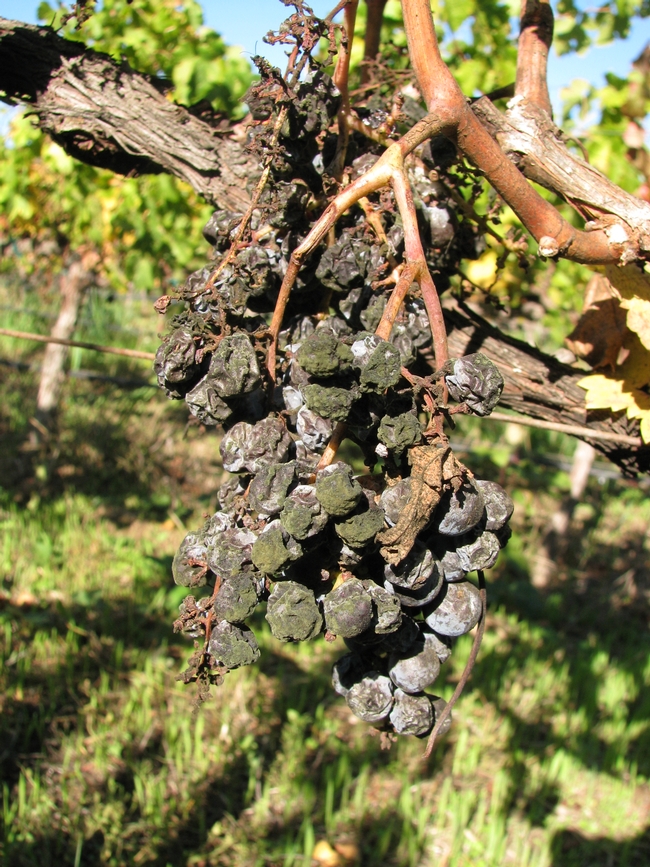
All common grapevine fungal pathogens exist inside vineyards. For example, fallen petioles, rachises that remain on the vine after mechanical harvest, pruning debris and woody tendrils that cling to trellis wires all support the growth of fungi. These fungi act as sources of inoculum that can infect wounds caused by pruning and suckering, and infect berries at bloom and other green tissue.
The fungi that colonize decaying berries include the same fungi seen growing on damaged berries before harvest including Botrytis cinerea and Cladosporium and Aspergillus species which are associated with Botrytis bunch rot, Cladosporium rot and sour rot respectively. Fungi can infect then colonize the ripening berries when spores enter through the slightest opening in the berry cuticle caused by sunburn or the presence of diffuse, unseen powdery mildew. Berries are an overwintering structures for these fungi and others.
Botrytis cinerea spores are ubiquitous given the fungus can survive on dead tissue as well as infect living tissue. It grows on dead calyptras (flower caps) and stamens after bloom and will infect a young berry through the wounds left when the cap is shed. In various studies, Botrytis sporulation in the lab occurred on petioles and rachises collected on the ground and remnants of rachises collected from canes after pruning.
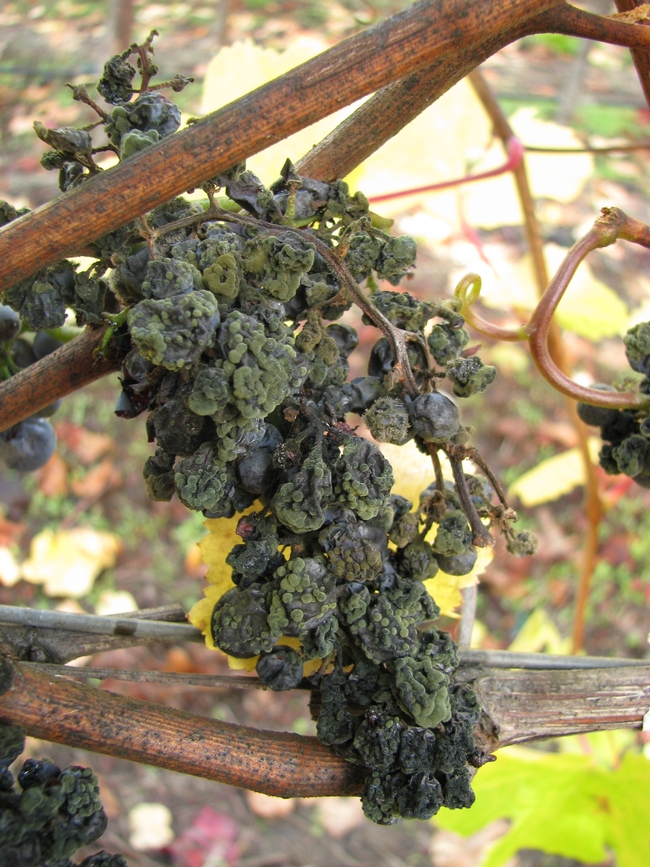
- Eliminating pruning debris will remove the inoculum formed on decomposing clusters and pieces of canes prior to bud break. Vineyard access to alternate rows is required to incorporate last year's wood and cluster remnants while maintaining resident vegetation or a sown cover crop in the non-tilled rows.
All common grapevine fungal pathogens exist inside vineyards and the relative importance of allowing unsold fruit to remain on the vines should be put into perspective of other vine tissues that are also decomposing. Clusters that remain in the vineyard are not likely to have a noticeable effect on disease the following year if common vineyard floor management practices are followed.
Acknowledgement: Valuable input provided by Dr. Akif Eskalen, Cooperative Extension Plant Pathologist, UC Davis.
- Author: Julia Van Soelen Kim
Two years ago today, Sonoma County residents awoke to fire spreading through urban and wild lands across our county, a dark cloud of smoke covering the sky, and ash blanketing the ground. There continues to be much work for our community to collectively recover from the fires--most of it is hard and heavy work, whether it be emotional work, community work, economic work, environmental work. UCCE Sonoma's Produce Safety after Urban Wildfire: Citizen Science Initiative is just one small piece of that body of work.
The project sought to find out if garden and farm-grown produce exposed to ash was safe to eat, mobilized community in the days and weeks after the fire to collect leafy greens from sites across the county for later analysis, formed a unique partnership between UCCE Sonoma, Petaluma Bounty, and a passionate public health researcher, Vanessa Raditz, and ultimately led to a workshop series, a newly published scientific report, a forthcoming toolkit for other communities affected by wildfire to assess the safety of their own unique context, and a collaboration with researchers from UC Davis School of Veterinary Medicine to investigate the safety of backyard chicken eggs in fire affected counties.
Today we honor the terrible toll of the fire on this community, and we welcome your participation in our upcoming Post-Fire Food Safety Workshop as a small piece of recovery and learning for the future. The workshop will be held on Thursday, Oct. 17, 2019 from 6:00pm-8:00pm at the Environmental Center of Sonoma County, 55 Ridgway Ave., Santa Rosa, CA 95401. Refreshments will be provided. RSVP at ucanr.edu/postfirefoodsafety10.17.19
- Author: Phil McRea, Master Gardener
- Contributor: Karen Giovannini
Updated links and republished Oct 2019.
Many residents in Sonoma County live in or near fire danger. For those who do live in a high fire area, knowing what to do when conditions are ideal for a forest (or urban fire) is essential.
Red Flag Warning
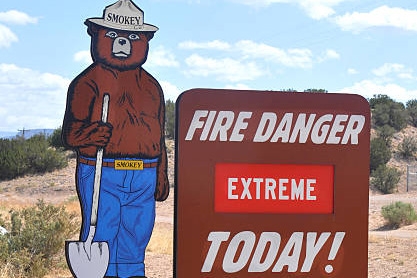
- Sustained wind speeds averaging 15 mph or greater
- Relative humidity 25% or less
- Temperature over 75 degrees F
Fuel Moisture Index
The fuel moisture index is a tool used to understand fire potential. 10-hour fuel moisture also known as Dead Fuel Moisture; when fuel moisture is <30%, it is essentially considered dead. 10-hour fuel moisture applies to grasses and bushes up to 1 inch in diameter. Learn more at NOAA.
The US National Weather Service warning is to inform area fire fighters and land management agencies that conditions are ideal for wild-land fire combustion. Cal Fire and local fire agencies all go on a high alert status under these conditions.
The Wind Cries...Santa Ana or Diablo?
The Santa Ana and Diablo winds occur throughout the year, but are extremely dangerous during dry periods (which, in Southern CA is practically year round). Santa Ana occurs in Southern CA, Diablo in the north. Winds come from the east from hot surfaces (deserts) and are compressed and speed up as they head towards the ocean. Learn more from SFSU. Check out current wind conditions at Windy.com.
Be Prepared
Here are some things you can do when Red Flag Warnings are issued. State and local news agencies usually announce Red Flag Warning 24-48 hours in advance on TV and radio, so there is time to act on short-term fixes.
During Fire Season
- Make sure garden hoses are hooked up and ready to use with spray nozzles attached; best practice is to never leave a garden hose randomly piled up as it will always tangle – if you want it coiled, coil it in equal sized oval loops with each successive loop offset few inches in the same direction.
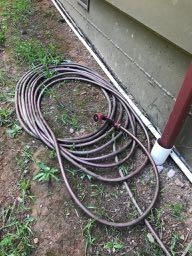 Garden hose ready to use
Garden hose ready to use - All portable propane tanks (BBQ, smoker, etc.) should be turned off and moved away from your house.
- If you have a pool: in an emergency, a pressure washer can be used to pump water from your pool and should be left in an available location; fire fighters should have clear access to your pool.
- Decks should be cleared above and below of flammable objects.
- Gas cans – for lawn mowers, chippers, whatever – should be moved away from house or garage/barn.
- Cover firewood stacks next to house with a fire resistant cover.
- Make sure cell phones are charged and ready for alerts and within hearing at all times.
- Close exterior doors and windows. Leave doors unlocked. Leave lights on inside and outside of house.
- If you have a ladder, leave it available outside, next to the house, in case fire fighters need to access roof.
- Have all your evacuation supplies such as flashlights and a good portable radio ready to go.
- Make sure your cars have plenty of gas and are parked outside, or garage door is capable of manual operation and all capable family members know how to open it.
- If appropriate, shut off gas supply line at the meter.
Ongoing Preparations
- Make an evacuation plan and collect all necessary supplies.
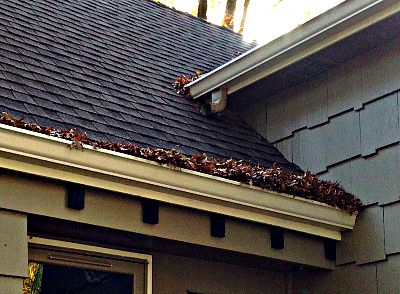 This gutter needs some cleaning
This gutter needs some cleaning - Clean gutters and roof debris regularly.
- Where possible, install mesh screening under decks to prevent burning material from blowing.
- Move firewood piles away from house.
- If you have a pool, research the special pump systems that are available for fire fighting.
- For more information obtain a free brochure: “Living with Fire in Sonoma County” from fire agencies of Sonoma County.
Learn more about disaster preparation and recovery on Disaster Recovery Resources.


